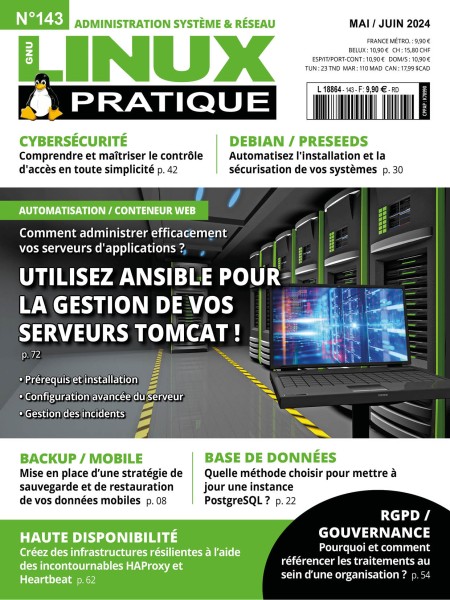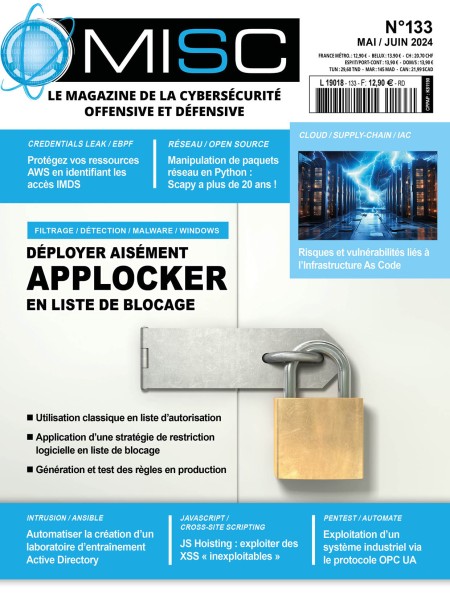? Revue de presse — mai 2024
En mai, lis ce qu'il te plaît ! Voici donc un petit panorama, forcément subjectif et parti{e,a}l, de la presse papier sortie récemment.

Les nouveautés de mai 2024 :
- GNU/Linux Magazine France no 269 embarque du Lua dans vos programmes ! ;
- Linux Pratique no 143 Utilisez Ansible pour la gestion de vos serveurs Tomcat ;
- MISC magazine no 133 fête les 21 ans de Scapy 🎂 ;
- Hackable no 54 s'attaque à votre pouvoir d'achat en vous proposant de mettre en place des communications gratuites hors réseau et longue distance avec Meshtastic ;
- Planète Linux no 136 utilise Yunohost pour déployer un service de streaming audio.
- lien nᵒ 1 : Revue de presse prcédente (mars 2024)
- lien nᵒ 2 : Éditions Diamond (Linux Magazine, Linux Pratique, MISC, Hackable)
- lien nᵒ 3 : Linux Pratique n°136
Les sommaires des numéros sortis depuis la précédente revue de presse
 |
 |
 |
||
|---|---|---|---|---|
 |
 |
GNU/Linux Magazine numéro 269
Au sommaire de ce numéro de mai – juin 2024 :
- Mettre en place un programme de Security Champions ;
- Embarquez un peu de Lua dans vos projets C ;
- NativePHP : développez des applications desktop en PHP !
- Écrire son premier pilote pour OpenBSD ;
- Manipulons les caractères avec iconv ;
- Les « tourments de la monopile », ou le « Single-Stack Syndrome » ;
- Les codes fantastiques : C for surprenant ;
- Le temps sous Linux - 1er volet.
Linux Pratique numéro 143
Au sommaire de ce numéro de mai – juin 2024 :
- Sauvegardez les données de vos appareils mobiles ;
- Mise à jour d’une instance PostgreSQL ;
- Automatiser l'installation et la sécurisation de systèmes GNU/Linux grâce aux preseeds ;
- Maîtriser le contrôle d'accès en cybersécurité ;
- Gouvernance et RGPD : référencez vos traitements ;
- Haute disponibilité avec HAProxy et Heartbeat ;
- Gérer son parc Tomcat avec Ansible.
MISC Magazine numéro 133
Au sommaire de ce numéro de mai – juin 2024 :
- Automatiser la création d’un laboratoire d’entraînement Active Directory ;
- JS Hoisting : exploiter des XSS « inexploitables » ;
- Exploitation d’un système industriel via le protocole OPC UA ;
- DenyLocker : utilisation d’AppLocker en liste de blocage, construction et validation automatique des règles ;
- Protégez vos ressources AWS en identifiant les accès IMDS ;
- Il y a comme un I(a)C ;
- Scapy a 21 ans !
Hackable numéro 54
Au sommaire de ce numéro de mai – juin 2024 :
- IAoT avec M5Stack ;
- i2c-tiny-usb : un bus i2c facilement accessible pour votre PC ;
- Lever et coucher de soleil sur ESP32 ;
- Meshtastic : communication longue distance, hors réseaux et gratuite ;
- Milk-V Duo : un minuscule SBC RISC-V à 8 € ;
- Carte à puce et microcontrôleur ;
- Sharp PC-G850V : le dernier des ordinateurs de poche.
Planète Linux numéro 136
Au sommaire de ce numéro d'avril — mai 2024 :
- Actualités ;
- Distribution : Br OS 23.10, une Brésilienne au désign sophistiqué ;
- Distribution : BlendOS v3 La distribution ultime ou l'usine à gaz absolue ?
- Distribution : Fedora La dernière version apporte une vitesse accrue ;
- Plasma 6 est sorti. Une version majeure de l'ex-KDE ;
- 5 jeux pour se divertir ;
- Auto-hébergement avec YunoHost ;
- Comparatif streaming audio personnel ;
- Sysadmin : Comment est gérée la priorité du CPU ?
- Sysadmin : Sécuriser ses recherches avec DNS-over-TLS ;
- Comprendre le fonctionnement du réseau ;
- Comparatif : quel logiciel pour surveiller son système Linux ?
- Gérez votre collection de photos avec Fotocx ;
- Réaliser un panoramique avec Hugin ;
- 16 logiciels nouveaux ou mis à jour à découvrir dès maintenant ;
- 6 astuces pour mieux utiliser vos logiciels et distributions ;
- Qui veut la peau de X86 (tribune) ?
Commentaires : voir le flux Atom ouvrir dans le navigateur












